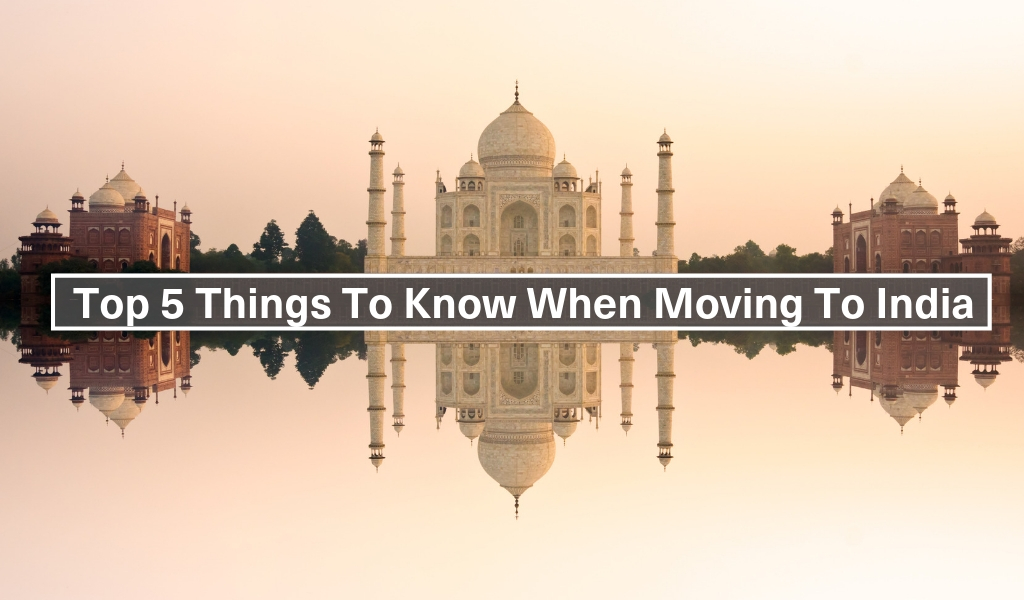Top 5 Things to Know When Moving to India
8th June, 2019

India is an exciting expat destination. It has a fast-growing economy, driven by a workforce of nearly 512 million people, including a 30,000-strong expat population. Expats will have the opportunity to be part of this rapidly expanding economy, while also immersing themselves in one of the most diverse cultures on the planet.
Relocating to India presents several challenges. The big cities, like Mumbai, Kolkata, New Delhi and Bangalore are hot, chaotic and perpetually busy. Without proper preparation and research, your arrival in India could be quite a shock.
The top 5 things you need to know when moving to India are:
- Culture and tradition are deeply rooted in Indian society
- Language is diverse. English is the language of business, while Hindi is spoken by approximately 30% of the population. However, there are 14 official languages and 37 different languages spoken throughout India
- Many houses and apartments in India do not have air-conditioning or ovens
- Bilateral agreements are in place to ensure expats don’t pay double on their tax
- The wet and dry seasons bring vastly different weather patterns to India.
Culture and Tradition are Deeply Rooted in Indian Society
India is home to a variety of cultures and traditions. Everything from language, customs and dress vary greatly between cities and regions. Despite these differences, the one commonality is that culture and tradition are a source of immense pride for all Indian people.
Expats should be respectful of these cultures and traditions. It is particularly important to learn about the customs specific to the area in which you are living.
There are some customs common to the entire country. Keep in mind that:
- Modesty is important throughout India; showing skin is disrespectful. So, while the weather is hot and humid, you should ensure that your shoulders, legs below the knee and cleavage are covered at all times. To survive the heat while being respectful, copy the local dress and invest in long, light fabrics.
- You should only shake hands and eat with your right hand. The left hand is used for bathroom duties and is therefore considered unclean. Eating with your left hand or extending your left hand in greeting is a sign of disrespect and poor behaviour.
Language is Diverse
Expats working in India are unlikely to need to learn Hindi or any of the other 14 official languages to conduct business. English is the language of business, and many Indians have a good command of the language, especially in the business and service sectors.
If you travel to regional India (particularly in the northern half of the country), you may find that English-speakers are limited. Given that Hindi is spoke by over 30% of the population, it is a good idea to learn a few key phrases in Hindi. In the southern states of India, you will find that many more people speak English than Hindi.
Read our Guide to Working in India for further information on Indian business culture.
Many Houses and Apartments Do Not Have Air-Conditioning or Ovens
It can come as a shock to move into a house or apartment in India and find that there is no oven or air-conditioner. The lack of air-conditioning can be particularly troubling in such a hot and humid climate.
Rest assured that you can purchase both items in large electric stores, with many stores offering free delivery to your home.
Bilateral Agreements Ensure Expats Don’t Pay Double On Their Tax
Many expats will be pleased to learn that they will pay considerably less income tax after relocating to India. Tax rates are generous, and there are bilateral agreements in place to ensure that you aren’t charged twice.
For further details, read the Indian Government’s information on this agreement between the governments of Australia and India.
You can read our Guide to Working in India for further information on tax rates.
The Wet and Dry Season Bring Vastly Different Weather Patterns to India
India is a vast country, full of varying climates. There are four main climatic zones in India:
- Arid: Western India is characterised by low rainfall and high temperatures
- Tropical: Southern India is hot and humid
- Sub-Tropical: Northern India has a sub-tropical climate, which gives it cold, dry winters and hot, wet summers
- Alpine Zone: The Himalayas run through India, although varying altitudes mean the weather varies a lot in this zone. Generally, the weather is hot and dry although snow is common at altitude.
Expats need to research the area in which they will reside to ensure they are prepared for the weather overseas. The major cities of India will be characterised by hot and humid weather, as they fall in the tropical and sub-tropical climatic zones. In these areas, there are essentially two seasons – wet and dry. In the wet season, be prepared for monsoonal weather and heavy, persistent rain that causes flash flooding.
Blog Author:





















